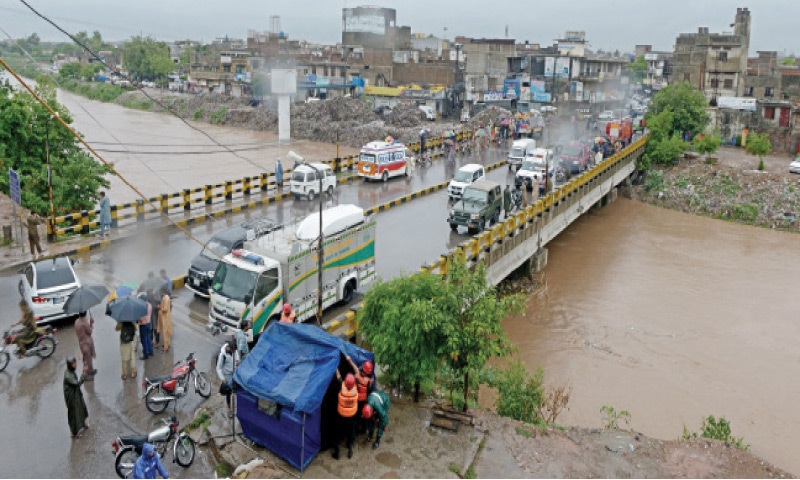Severe Flooding Hits Rawalpindi and Islamabad
Torrential rains have led to severe urban flooding in Rawalpindi and Islamabad, with water levels rising sharply in the Nullah Leh. The situation has prompted authorities to issue a high alert, with flood sirens sounding at the Gawalmandi Bridge to warn residents of the growing danger. Emergency services are on high alert, ready to respond swiftly to any developments.
Critical Water Levels
Officials from the Water and Sanitation Authority (WASA) and the district administration reported that water levels at the Gawalmandi point of Nullah Leh have reached 15 feet, dangerously close to the critical 20-foot mark. At the Katarian Bridge, the water level has already climbed to 16 feet. If these levels continue to rise beyond the danger threshold, authorities will initiate evacuations of nearby residential areas.
Impact on Communities
The continuous heavy rainfall has submerged many low-lying areas, trapping hundreds of people inside their homes. Several key parts of the city, including Mehar Colony, Dhoke Hassu, Pirwadhai, Khayaban-e-Sir Syed, Fauji Colony, and Dhoke Matkyal, are severely affected by the flooding.
Rainwater has entered numerous homes, and several connecting bridges are now completely underwater, making movement difficult. Authorities have urged residents to follow safety instructions closely and move to higher ground whenever possible to avoid harm. The situation remains tense as water continues to rise.
Emergency Response Efforts
Rescue 1122, WASA, Civil Defence, and other emergency teams are working around the clock to manage the crisis. The Managing Director of WASA has also contacted the 111 Brigade, and arrangements are in place for the Pakistan Army to assist if the flooding worsens further. Community cooperation is essential during this time of need.
Ongoing Monitoring and Preparedness
Authorities continue to monitor the situation closely and are prepared to take swift action to protect lives and property. Residents are advised to stay informed through official channels and avoid unnecessary travel until the floodwaters recede. The coming hours will be critical for the flood response efforts in Rawalpindi.
Safety Measures and Public Awareness
Emergency services have emphasized the importance of public awareness and adherence to safety guidelines. Residents are encouraged to remain vigilant and heed all warnings issued by local authorities. The use of designated safe zones and evacuation routes is being prioritized to ensure the safety of those in affected areas.
Future Outlook
As the monsoon season continues, the risk of further flooding remains a concern. Authorities are working to enhance preparedness and improve infrastructure to mitigate future impacts. Public engagement and community support play a crucial role in ensuring effective disaster management and recovery.
Conclusion
The ongoing floods in Rawalpindi and Islamabad highlight the urgent need for coordinated efforts between government agencies, emergency services, and the local population. With continued monitoring and proactive measures, authorities aim to minimize the impact of the current crisis and build resilience against future natural disasters.







